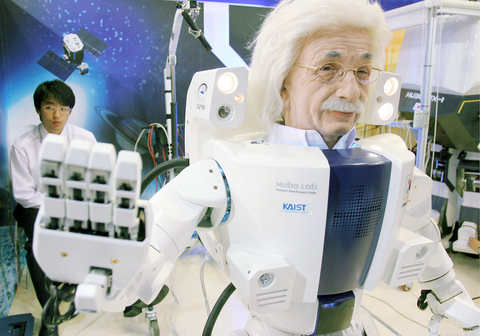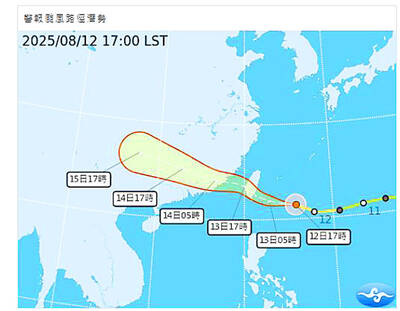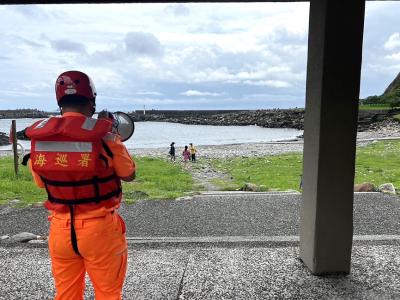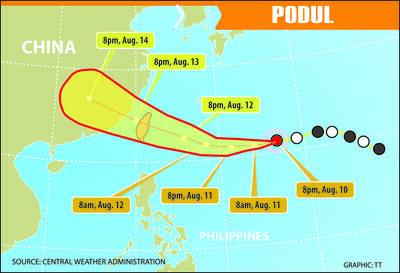Robots that smile and blink. A "ubiquitous" Internet that envelops people in an always-wired world. Radio ID tags on every product and person, letting you check whether the wine you're thinking of buying will go with that steak or if your children have arrived safely at school.
These visions of the future were among innovations exhibited on Tuesday on the sidelines of the APEC summit.
South Korea, which leads the world in per-capita high-speed Internet connections and is a major producer of memory chips and flat-screen displays, is showcasing its technological prowess during this week's APEC forum in Busan.

PHOTO: EPA
World leaders and other APEC delegates are getting the chance to participate in the first-ever trial of wireless high-speed Internet access called WiBro.
The technology, based on the worldwide WiMax standard, allows users to surf the Web at speeds almost as fast as wired connections while moving, also enabling voice and video calling via the Internet.
The service will be offered to South Korean consumers next year, in the form of WiBro-enabled phone handsets, laptop computers and expansion cards.
The move is part of South Korea's campaign to create a "ubiquitous" information society, including everything from e-health to e-learning to e-government.
"When we're in the ubiquitous era, we'll be living in a world where we have knowledge and robots everywhere," Information and Communication Minister Chin Dae-je told journalists.
The star of the showcase is a 137cm tall, two-legged robot topped with a head modeled after Albert Einstein. "Albert Hubo" has 31 motors behind its face allowing it to laugh, blink -- and even scowl when someone tries to tip it over. It can also speak in sign language using its five-fingered hands.
"Our first goal is to make robots as similar to humans as possible," said Oh Jun-ho, director of the government-funded Humanoid Robot Research Center, declining to speculate on the applications for such a machine.
But one of the demonstrations provides a possible hint: a robot-staffed bar a la Star Wars.
Also on show was digital multimedia broadcasting (DMB), a service unveiled this year in South Korea that delivers TV broadcasts and music to mobile phones via satellite. The country aims to establish DMB as a worldwide standard to keep people's eyes glued to their handsets.
For those wanting the big picture, Samsung and LG showed off massive plasma screens measuring 260cm diagonally that they said were the world's largest.
Other innovations planned for rollout in coming years are radio ID tags on all products, so people with properly equipped phones can wave them in front of a bottle of wine and get information on whether that year was a good vintage. Children with radio tags built into phones will check in at sensor stations when they arrive at school, triggering a text message sent to their parents to let them know they got there safely.

GET TO SAFETY: Authorities were scrambling to evacuate nearly 700 people in Hualien County to prepare for overflow from a natural dam formed by a previous typhoon Typhoon Podul yesterday intensified and accelerated as it neared Taiwan, with the impact expected to be felt overnight, the Central Weather Administration (CWA) said, while the Directorate-General of Personnel Administration announced that schools and government offices in most areas of southern and eastern Taiwan would be closed today. The affected regions are Tainan, Kaohsiung and Chiayi City, and Yunlin, Chiayi, Pingtung, Hualien and Taitung counties, as well as the outlying Penghu County. As of 10pm last night, the storm was about 370km east-southeast of Taitung County, moving west-northwest at 27kph, CWA data showed. With a radius of 120km, Podul is carrying maximum sustained

Tropical Storm Podul strengthened into a typhoon at 8pm yesterday, the Central Weather Administration (CWA) said, with a sea warning to be issued late last night or early this morning. As of 8pm, the typhoon was 1,020km east of Oluanpi (鵝鑾鼻), Taiwan’s southernmost tip, moving west at 23kph. The storm carried maximum sustained winds of 119kph and gusts reaching 155kph, the CWA said. Based on the tropical storm’s trajectory, a land warning could be issued any time from midday today, it added. CWA forecaster Chang Chun-yao (張竣堯) said Podul is a fast-moving storm that is forecast to bring its heaviest rainfall and strongest

TRAJECTORY: The severe tropical storm is predicted to be closest to Taiwan on Wednesday and Thursday, and would influence the nation to varying degrees, a forecaster said The Central Weather Administration (CWA) yesterday said it would likely issue a sea warning for Tropical Storm Podul tomorrow morning and a land warning that evening at the earliest. CWA forecaster Lin Ting-yi (林定宜) said the severe tropical storm is predicted to be closest to Taiwan on Wednesday and Thursday. As of 2pm yesterday, the storm was moving west at 21kph and packing sustained winds of 108kph and gusts of up to 136.8kph, the CWA said. Lin said that the tropical storm was about 1,710km east of Oluanpi (鵝鑾鼻), Taiwan’s southernmost tip, with two possible trajectories over the next one

TALKS CONTINUE: Although an agreement has not been reached with Washington, lowering the tariff from 32 percent to 20 percent is still progress, the vice premier said Taiwan would strive for a better US tariff rate in negotiations, with the goal being not just lowering the current 20-percent tariff rate, but also securing an exemption from tariff stacking, Vice Premier Cheng Li-chiun (鄭麗君) said yesterday. Cheng made the remarks at a news conference at the Executive Yuan explaining the new US tariffs and the government’s plans for supporting affected industries. US President Donald Trump on July 31 announced a new tariff rate of 20 percent on Taiwan’s exports to the US starting on Thursday last week, and the Office of Trade Negotiations on Friday confirmed that it